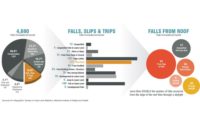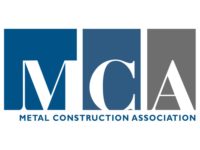AAMA's Skylight Council Publishes Fall Protection Paper
Responding to heightened industry and
public concerns about fall prevention, the American Architectural Manufacturers
Association's (AAMA's) Skylight Council has published a position paper entitled
Fall Protection, which provides practical suggestions for minimizing and
preventing falls through roof openings.
SCHAUMBURG, Ill. - Responding to heightened industry and public concerns about fall prevention, the American Architectural Manufacturers Association's (AAMA's) Skylight Council has published a position paper entitled Fall Protection, which provides practical suggestions for minimizing and preventing falls through roof openings. Highlighted within the paper, Fall Protection notes the American Society for Testing and Materials (ASTM) work group's findings, which attribute most skylight injuries to incidents involving other products and conditions unrelated to skylight products. According to the paper, ASTM also is investigating the development of a skylight fall protection test standard, but its work group asserts that such development is somewhat premature, as there is insufficient data on the risk of skylight-related incidents.
“The issue as it has been presented by ASTM, and by inaccurate information disseminated through various industry organizations, does not correlate with the experiences of the manufacturer members of AAMA's Skylight Council,” said John Westerfield (CrystaLite, Inc.), chairman of the AAMA Skylight Fall Protection Task Group. “Until we get complete and reliable data, it will be difficult to discover and focus on the true hazards.”
While the issue of fall protection raises numerous questions, the most important question from the AAMA Skylight Council's perspective is, “How can falls through roof openings be prevented?” Fall Protection provides several practical suggestions for minimizing and preventing such falls:
“AAMA's Skylight Council believes fall protection is a shared responsibility amongst the many parties involved with the design, construction and maintenance of roofs, and we acknowledge all aspects of health, safety and welfare relating to skylights,” said John Lewis, AAMA technical director. “AAMA will continue its commitment to roof safety through the efforts of our members and advisors such as the AAMA Fall Protection Task Group, which developed this paper, and continues to participate in ASTM's work group on development of a skylight fall protection standard.”
For more information, visit www.aamanetstore.org.
SCHAUMBURG, Ill. - Responding to heightened industry and public concerns about fall prevention, the American Architectural Manufacturers Association's (AAMA's) Skylight Council has published a position paper entitled Fall Protection, which provides practical suggestions for minimizing and preventing falls through roof openings. Highlighted within the paper, Fall Protection notes the American Society for Testing and Materials (ASTM) work group's findings, which attribute most skylight injuries to incidents involving other products and conditions unrelated to skylight products. According to the paper, ASTM also is investigating the development of a skylight fall protection test standard, but its work group asserts that such development is somewhat premature, as there is insufficient data on the risk of skylight-related incidents.
“The issue as it has been presented by ASTM, and by inaccurate information disseminated through various industry organizations, does not correlate with the experiences of the manufacturer members of AAMA's Skylight Council,” said John Westerfield (CrystaLite, Inc.), chairman of the AAMA Skylight Fall Protection Task Group. “Until we get complete and reliable data, it will be difficult to discover and focus on the true hazards.”
While the issue of fall protection raises numerous questions, the most important question from the AAMA Skylight Council's perspective is, “How can falls through roof openings be prevented?” Fall Protection provides several practical suggestions for minimizing and preventing such falls:
- Established safety procedures, properly implemented and followed, are the foundation for mitigating falls from roofs and roof openings. Special circumstances may call for the use of railings, grids or other products that meet fall protection standards.
- Because of the number of potential fall hazards present, roof access should be limited to construction and building maintenance professionals; it is up to building owners to take whatever reasonable means are necessary to achieve this.
- Strict compliance with all applicable Occupational Safety and Health Administration (OSHA) regulations.
- Proper training on roof safety. All potential roof hazards, as well as any safety measures that must be implemented, have to be communicated to workers by qualified personnel, who also must ensure that they are understood. In turn, workers need to be competent, have a sense of personal responsibility, and a strong sense of personal safety.
- All access points to the roof should contain signage regarding roof safety and inherent dangers.
- Warning labels on skylights, which have been a universal building code requirement since 1986, are another fall prevention element. Such warnings can be further amplified by signage at all access points.
“AAMA's Skylight Council believes fall protection is a shared responsibility amongst the many parties involved with the design, construction and maintenance of roofs, and we acknowledge all aspects of health, safety and welfare relating to skylights,” said John Lewis, AAMA technical director. “AAMA will continue its commitment to roof safety through the efforts of our members and advisors such as the AAMA Fall Protection Task Group, which developed this paper, and continues to participate in ASTM's work group on development of a skylight fall protection standard.”
For more information, visit www.aamanetstore.org.
Looking for a reprint of this article?
From high-res PDFs to custom plaques, order your copy today!





